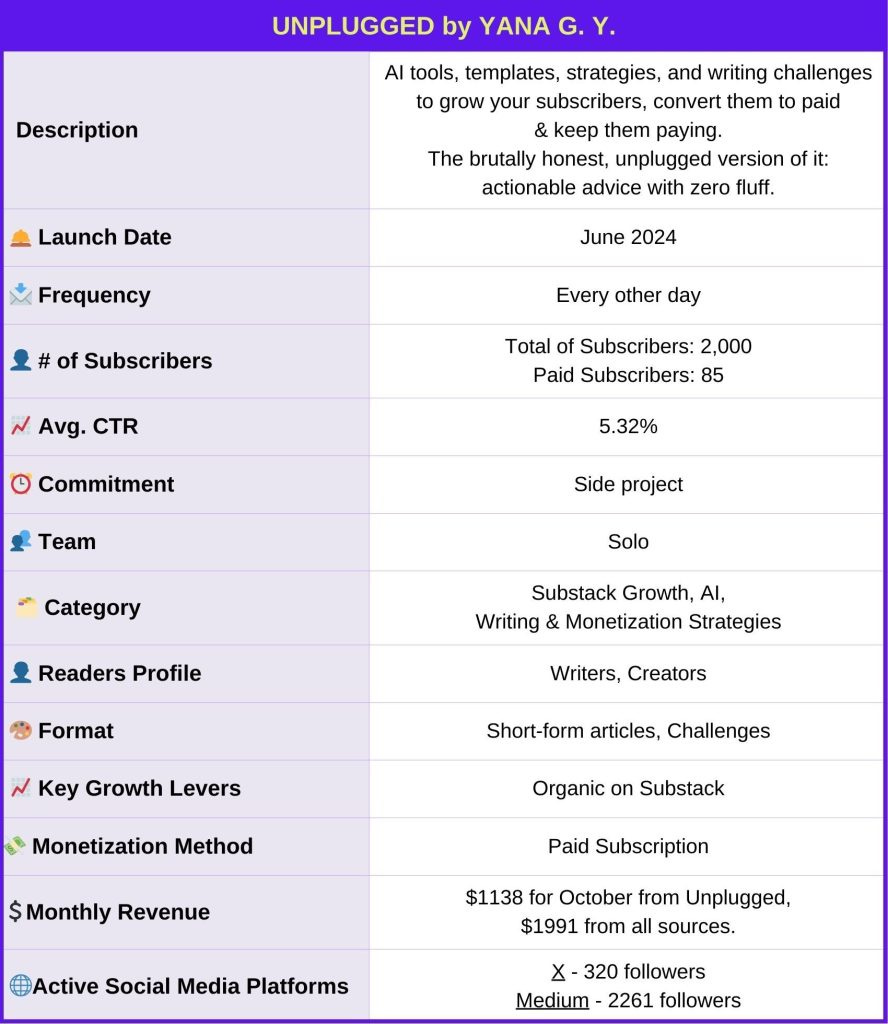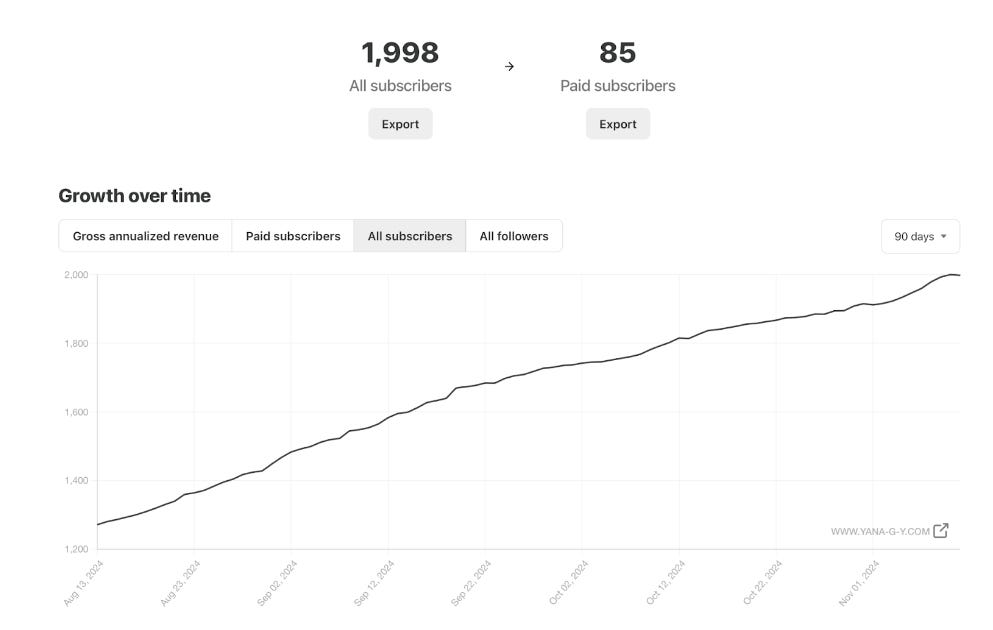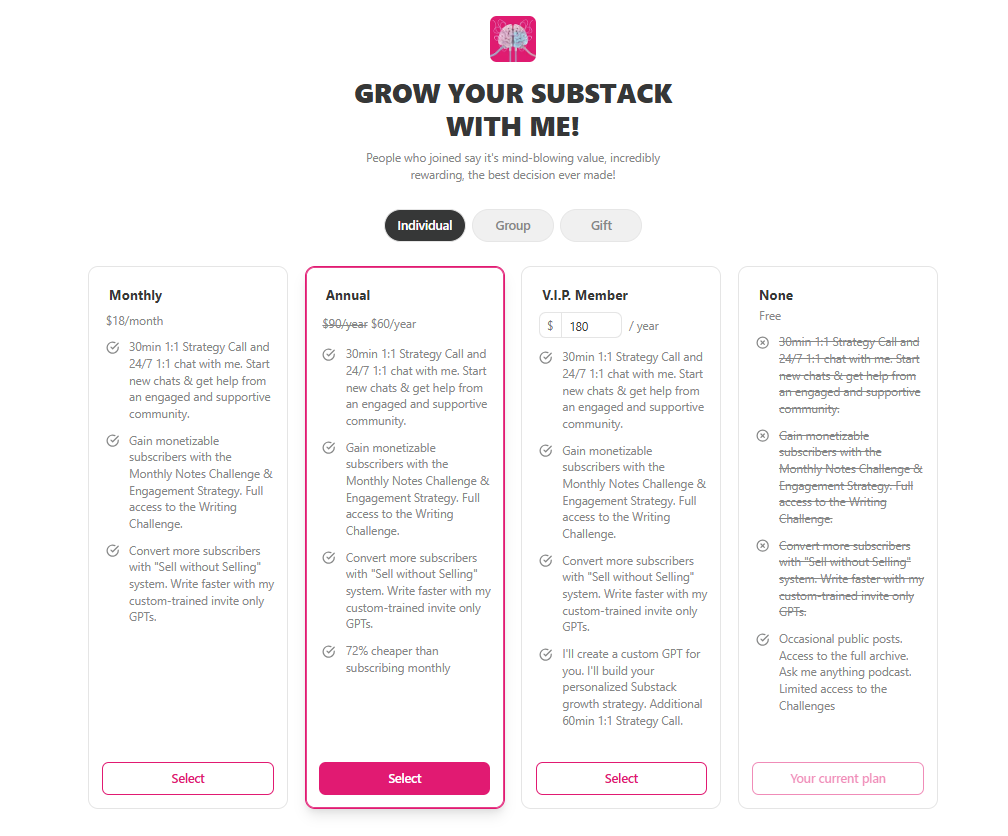Unplugged by Yana G. Y.
How Yana G.Y. grew her newsletter to over 2,000 subscribers and 85 paid members within only 5 months.
Newsletter Circle is your go-to source for building a successful newsletter business.
SUBSTACK REPORT
I analyzed over 74K Substack newsletters!
Sign up if you want to get the FREE report next week.
Hey everyone,
This week, I interviewed
, a 9-5 corporate employee and a newsletter operator with over 2,000 subscribers and 85 paid ones within just 5 months.Enjoy!
MEET THE CREATOR
Yana G. Y. has been a corporate employee for 15 years in a big tech company in Europe, where she leads product management teams covering markets in 6 countries, creating subscription-based services.
In addition to her 9-5 schedule, she also runs 3 different newsletters!
- on helping writers get started and monetized on Substack, and about writing & using AI. (on Substack)
Have a GUT Time, on mastering your emotions. (on Substack)
CREATIVE BiTES, on writing and making money online with AI. (on Kit)
She also builds the CREATIVETECH HUB – a place to help creators grow faster online with many tools, including AI.
She applies a lot of her business background to their newsletters, which works well for her.
In this interview, we’ll look into only one of her newsletters which is “Unplugged”. Yana shared valuable insights with us on:
how she used Substack Notes and Medium to grow her audience to 2,000 subscribers
her learnings on paid subscriptions and how she got 85 paid members within 5 months
productivity hacks that help her run 3 newsletters in addition to her full-time job
and many more…
NEWSLETTER IDENTITY CARD
TOOL STACK
ESP: Substack
Writing: ChatGPT, GPTZero, The Hemingway, Grammarly
Video Design: Pictory AI, Eleven Labs AI, Loom, InShot
Task Management: Notability
Curation & Note-taking: Notability, Excel, Google Sheets
Visual Design: Midjourney
Growth: Substack
Digital Products: Gumroad, Amazon KDP
Social Media Tools: Make
Payments: Stripe
START
How and why did you start Unplugged in the first place?
I created my account on Substack in March 2023 but back then I was convinced there was no discoverability, so I started building my subscriber list on Medium and social media.
I tested and researched what worked on Medium until February 2024, when I decided to go all in with my writing business. I quickly grew as I applied what I’ve learned. I built a great community on Medium with my publication called CREATIVETECH Friends.
In May’24 Medium decided to change their strategy and my metrics there started to go down. I don’t feel their new policies about AI and engagement on the platform work in favor of writers or Medium overall.
They started to massively block and revoke accounts, just because people engaged with each other. It suddenly became “illegal” to maintain an engaged community. It became a toxic place for a lot of us. I understand Medium needed to get profitable fast, so this was the moment I realized I wasn’t at the right place.
Medium’s business model does not favor writers. If I make more money, they make more costs. This is not the case with Substack—if I make money, they make money, too. As someone who understands business, this was a huge a-ha moment.
In June 2024 I found out about Notes and I kicked off the Unplugged newsletter. I already had about 1000 subscribers and I decided to give it a try. Some people from Medium followed my lead.
I had no strategy or clarity on monetization. At that time I just tested the platform, while researching what works and what doesn’t, basically repeating the same process I applied on Medium.
And it worked!
I wasn’t very consistent with writing or posting Notes, but because of my audience from Medium and my activity on Substack, I gained about 400 new subscribers and 20 paid subscribers by the end of August.
This was the moment when I decided to go all in, build my strategy, and kick it off.
GROWTH
You grew your subscriber number from 0 to 2,000 subscribers in less than 5 months. Which strategies did you use to reach over 2,000 subscribers?
I finished my research and created my strategy in August, and I kicked it off on September 1st.
I believe there are three growth pillars on Substack:
Using Notes – I started posting Notes every day. This works when you have more subscribers, who are also active in the app. They are the first to see your Notes and when they interact, people from their audiences start seeing it. It’s a snowball effect.
Interacting with others – if you don’t have subscribers (I believe less than 500 people coming organically from Substack, not imported), this is the way to grow. You’re basically using the same snowball effect and people start noticing you.
Recommendations – when you start recommending others, some of them start recommending you too. True fans also do it even if you don’t recommend them.
“Right now almost half of my organic subscribers are generated from Notes and almost another half from recommendations.”
I recently also started getting new subscribers from Google, which is awesome.
I designed my newsletter to help other writers grow on Substack and my concept is very simple. I test different ways to grow and I share what works and what doesn’t with my paid members. Some of it is for free.
I also have challenges, where I implement everything a writer needs to grow on Substack – that is especially valid for my Notes Challenge. It’s a pack of resources about how to write Notes and interact on the platform to grow faster – everything I use for myself.
I also have a writing challenge to keep writers consistent, as it’s important for monetization. Both challenges are running monthly.
What are your key strategies to grow your audience via Medium?
I did my research and testing of strategies during March 2023 – February 2024. Then I went all in. Medium really is simple: you need to write daily and stay active on the platform, building relationships with your audience.
I also started a publication there and created a community around it, which helped me gain loyal readers. Then I decided to start Substack and started writing about it too.
I imported my Medium subscribers to Substack, some of which immediately became paying subscribers as they already trusted me. Others joined as paid subscribers later on my journey.
I think what attracted them the most was the fact that I am sharing my exact strategies to help them grow faster on Substack. Still others supported me with recommendations, which was significant, as their Substack publications were also growing fast. I recommended them back of course.
What are your key strategies to grow your audience via Substack Notes?
I wasn’t very consistent during that time, but I did try to post a Note every now and then (not every day), and engage with others on the platform, just to get to know it.
I started using Notes more strategically after that time, so I can’t say it was some sort of strategy. All you need is just to be present and authentic there. And active – interact with others, exchange ideas, and have meaningful conversations.
It is all about community. This helps gain free subscribers and some paid ones. Right now Notes is the channel with one of the highest conversion rates.
I created my own strategy for Notes and applied it since September, which boosted my growth even more – I have some days with more than 20 new subscribers. But this also depends on Substack algorithm and how they distribute my content.
The strategy in a nutshell: write about what I write in my newsletter, engage with potential paid subscribers (similar profiles to my existing paid subscribers), and stay consistent with both. That’s it 🙂
This strategy (in much greater detail) is part of my Notes Challenge here.
I think what helped me convert these subscribers to paid ones is the following:
Writing consistently
One Note a day, at least one post every week
Enabling payments right from the start and paywalling the most valuable part of my writing (not the whole post)
Engaging with others on the platform
Staying active in chats, reading, commenting, and restacking their content, etc.
The Notes that gained the most traction are about:
my audience’s pain points
my journey on Substack – especially Successes & Milestones and how I got there
topics I write in my paywalled posts
It all needs to be connected.
MONETIZATION
You applied paid subscription right from the beginning. How did you decide to start a newsletter with a paid plan ahead?
I believe I needed to be aligned with Substack’s business model. Simply said, I needed to open payments so that I could fully utilize all Substack features. And since I started getting paid subscribers right from the start, even without a clear strategy or consistency, I decided to push further and build upon it.
You offer monthly challenges on writing and monetization to your paid members. Why did you prefer to include those challenges in your paid plan? What are the benefits for you and your members?
My research indicated that community features are what really matters for direct monetization, so I added tons of value to my challenges and paywalled them.
I have templates, custom GPTs trained to generate high-quality content, instructions, tracking sheets, and much more all for paid subscribers only, but I let all subscribers participate so that I can grow the community.
Since November, I added a prize to motivate people to stay consistent – the most active will be entitled to a spotlight session with me where they can talk about their newsletter.
I believe the challenges are one of the major things that made a big difference in my growth. Yet, you need to have some audience to start them, otherwise they don’t make much sense.
Your newsletter is only 5 months old and you already have 85 paid subscribers. What are your biggest acquisition channels for paid subscribers?
The channel with the highest conversion rate for me is Substack app. I believe it’s because of my activity on the platform with Notes and engagement with other writers.
What are your biggest learnings when applying for a successful paid subscription?
This is not just a writing business. It’s a service business. A lot of writers don’t get it and give up too early, but I know how this works from my 9-5. You have to have that knowledge to succeed, and this is what I provide as a service to my paid subscribers.
SYSTEM AND PRODUCTIVITY
You run three different newsletters, two of which are on Substack and the other one on Kit. How do you manage your time to keep up with all your newsletters? Do you have any productivity tips?
I love that question! A lot of people ask me how I do it since I also have a 9-5 and I travel a lot. I do have a content creation system, here it goes:
I post a Note
I turn it into a post for free subscribers on Substack and Medium
That saves me a lot of time, which I use to create content for paid members. I try to get up early, but it’s not my thing. I write in the evenings mostly after dinner. I maintain my community on Medium and schedule my Kit newsletter during the weekends.
My top productivity hacks:
Move the body
Get enough sleep
Skip meals whenever you can
Forget about sugar and white flour, limit milk
Do some mindfulness (meditation, breathing, reflection)
Make sure you have healthy relationships, get rid of toxicity
It’s all about how you take care of yourself and much less about how you organize your time. We all don’t have time, so we need to make the time. And you can do it only if you have the right mindset.
IMPACT & LEARNINGS
How did building Unplugged newsletter contribute to your life professionally and personally?
I feel at home on Substack. I hope it stays like this and doesn’t change. I feel it perfectly fits into my universe. The fact that I am building something on my own is giving me a whole new bunch of enthusiasm which also helps me in my 9-5.
I use all my knowledge and get tons of ideas from my 9-5 which I use for my newsletters. I feel a better person after I started writing. It elevates your thinking and helps you grow. Everyone should do this, it’s amazing!
What would you do differently if you had a chance to start over Unplugged?
I’d start earlier. I learned about Notes almost a year after it launched, so, I could start much earlier.
I wouldn’t import subscribers, as they’re less active on the platform and my open rates suffer.
I’d not put too much effort into building guides, books, and digital products. Services are a better way – you work less and earn more.
What would it be if you had the right to give one piece of advice to aspiring newsletter creators?
Every writer should have a paid newsletter. Right now I believe it’s the best way to grow online and Substack is the best place to do it. And if you get stuck, DM me. 😉
3 Popular Unplugged Issues
Where to find Yana G. Y.
*indicates affiliate links
👉 Do you want to reach 2,800 newsletter operators & enthusiasts?
Thanks for reading, and don’t hesitate to reply if you want to contact me.
Ciler








FELICES Y GRACIAS
FELICES Y GRACIAS